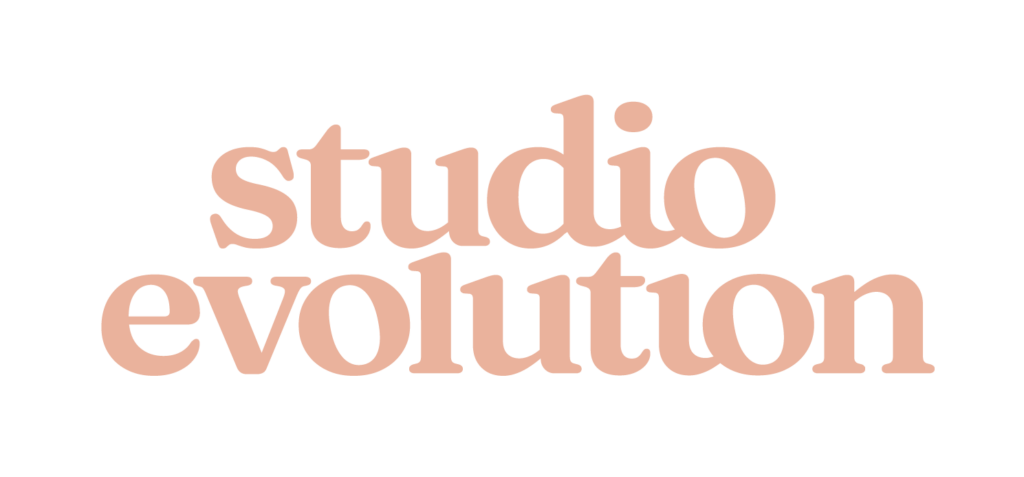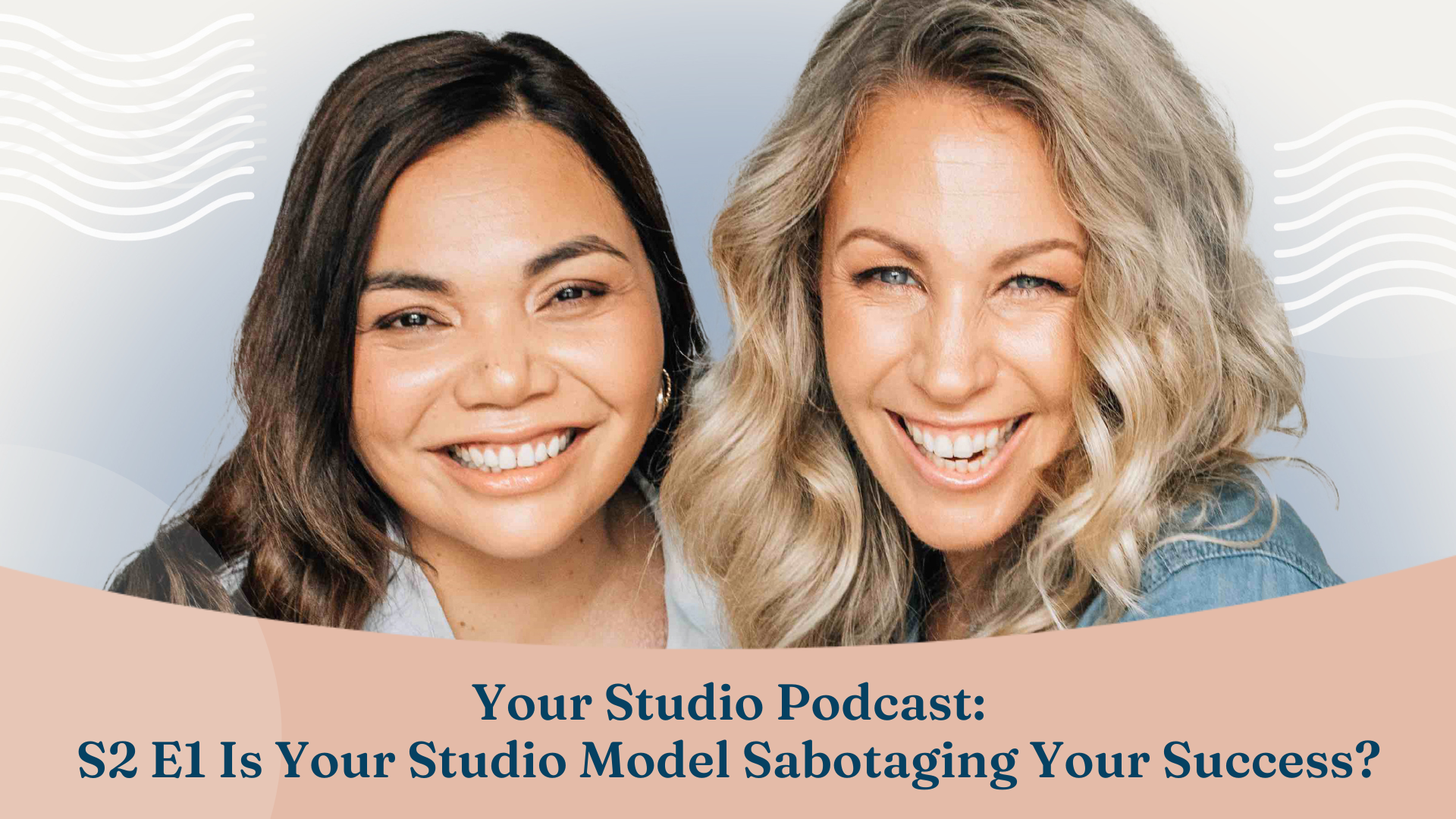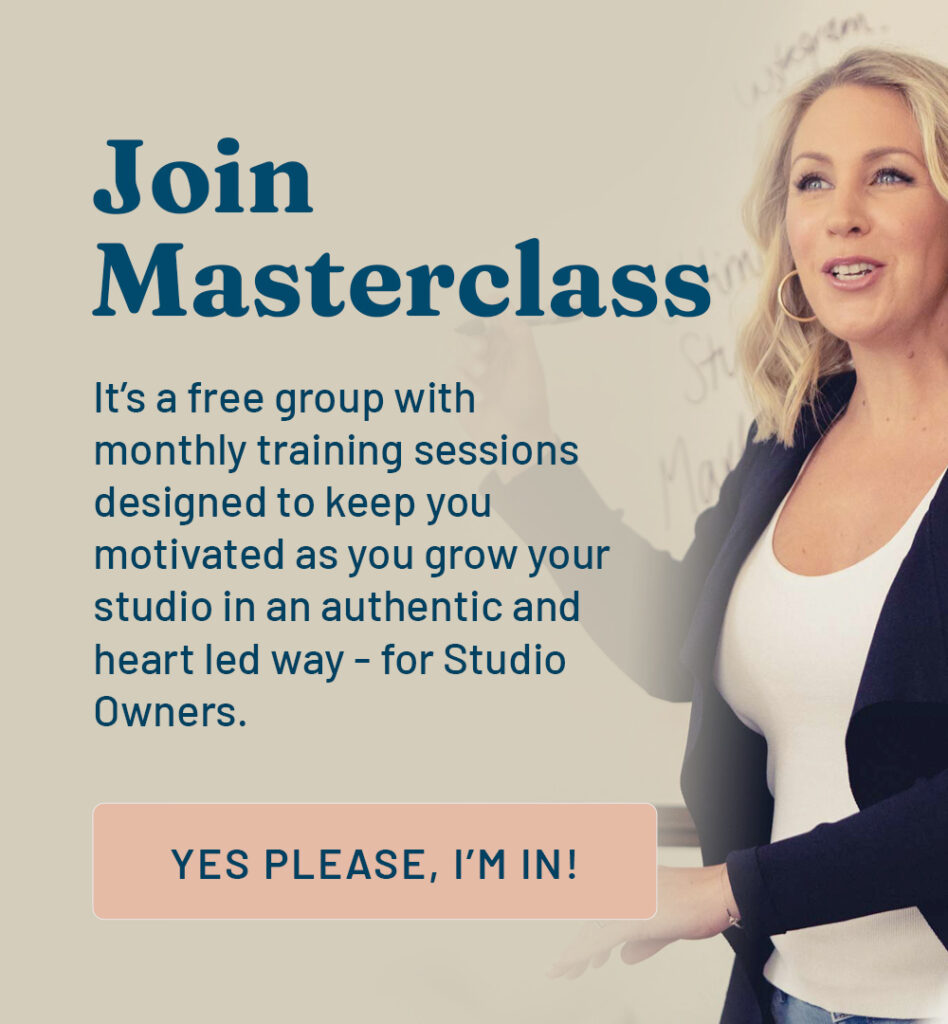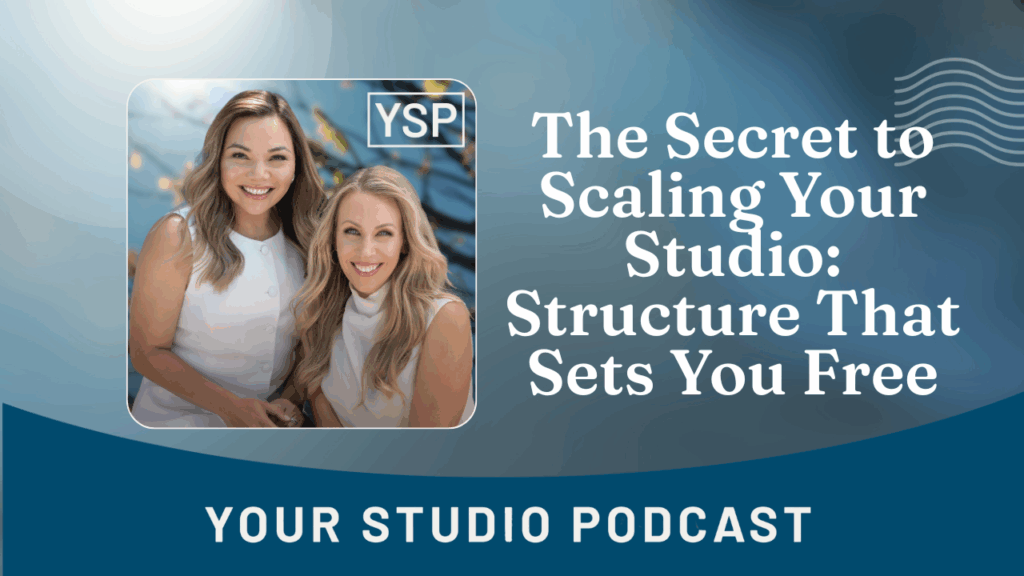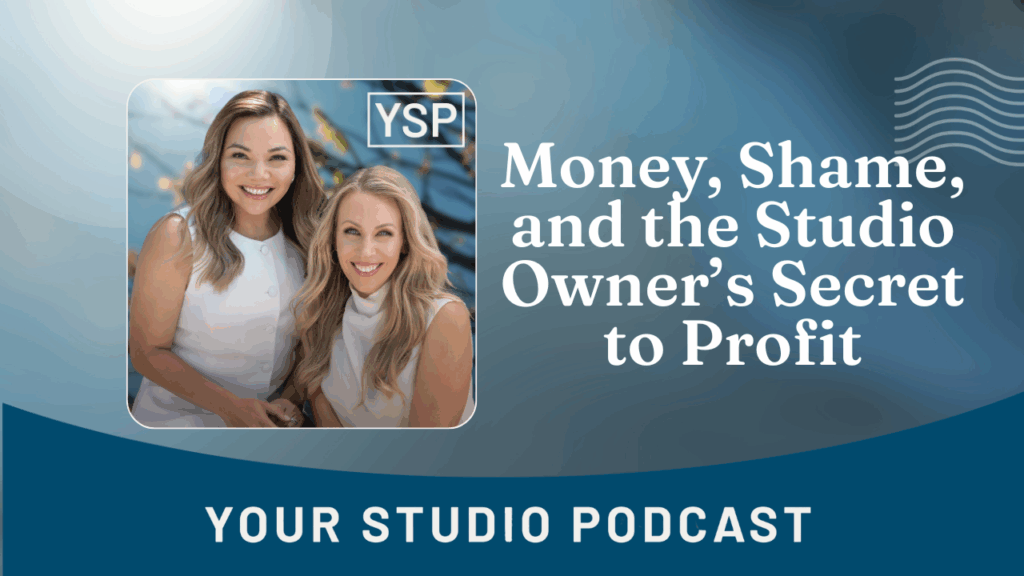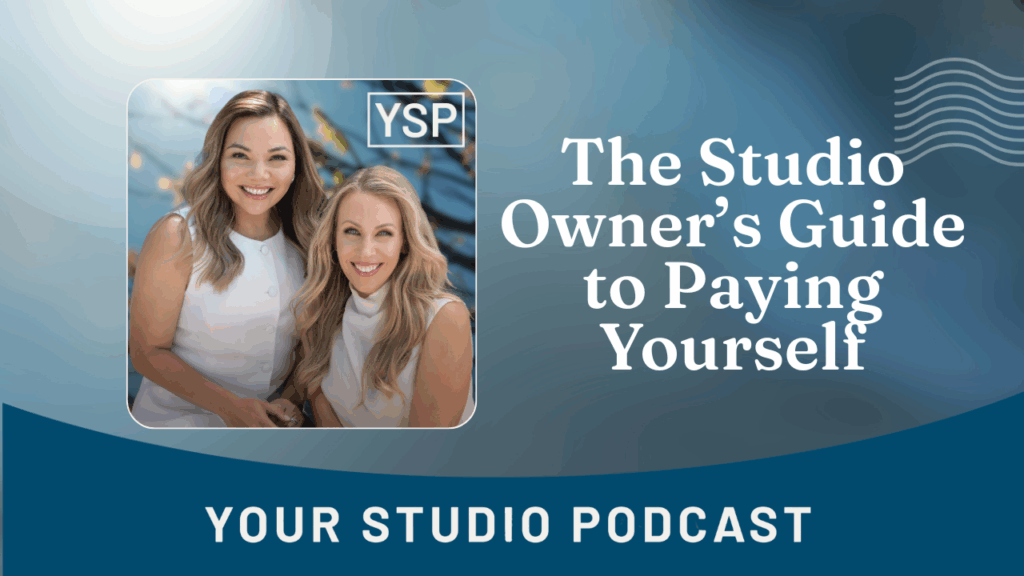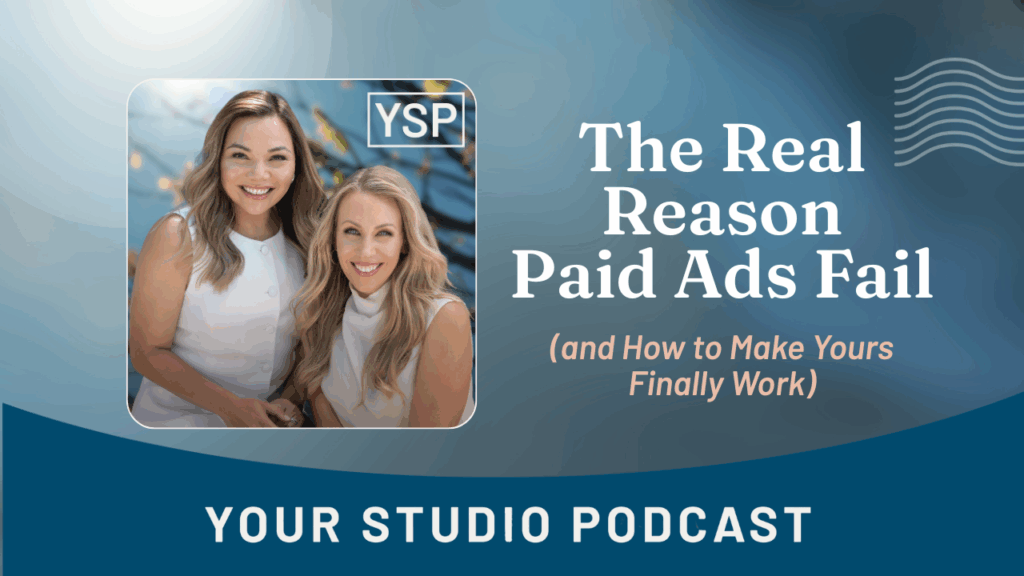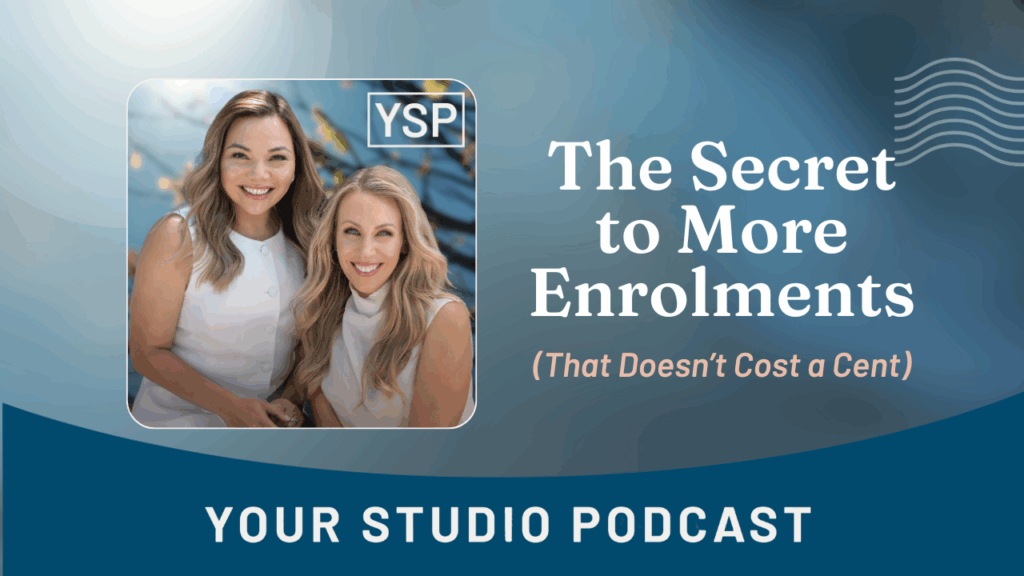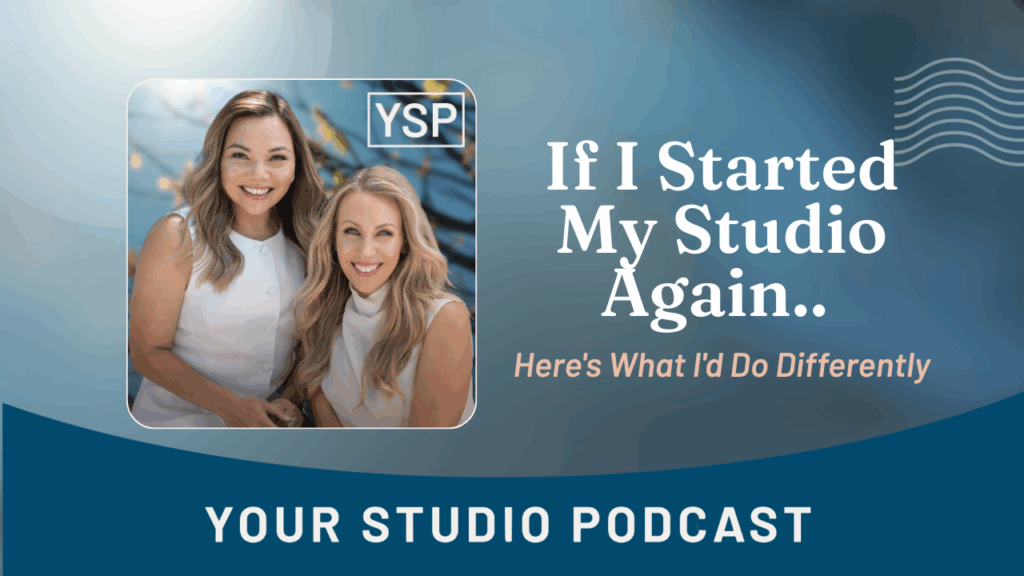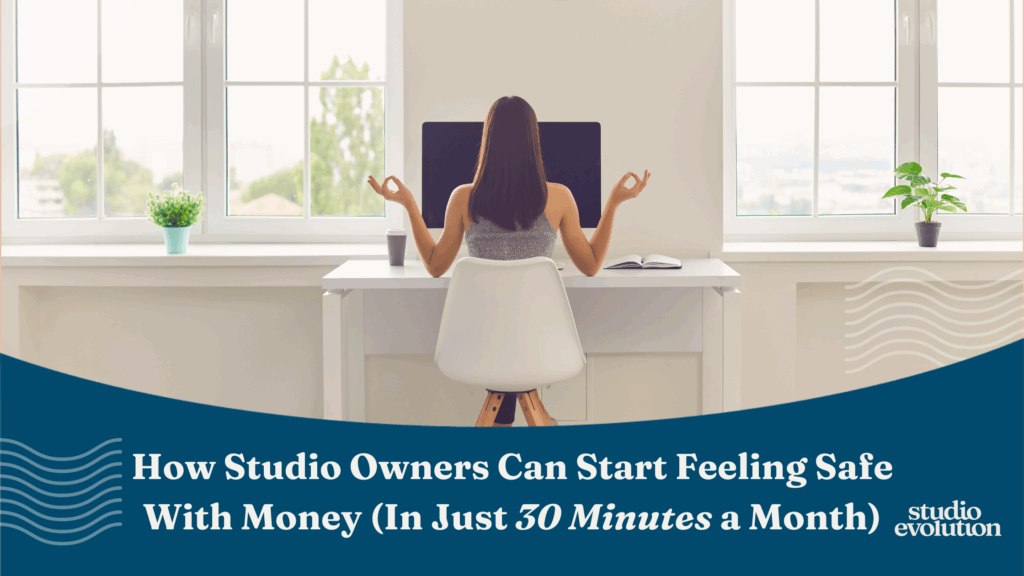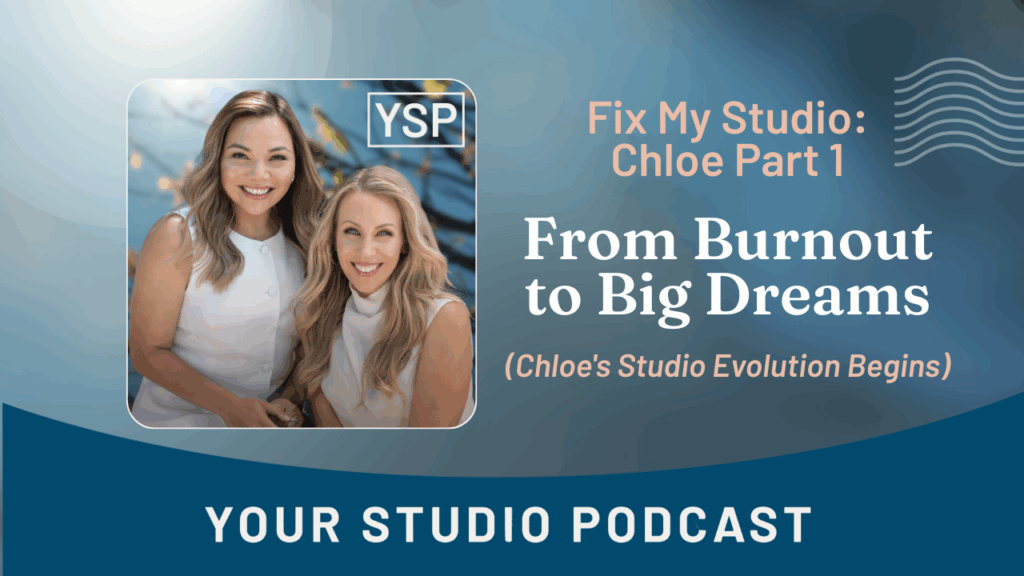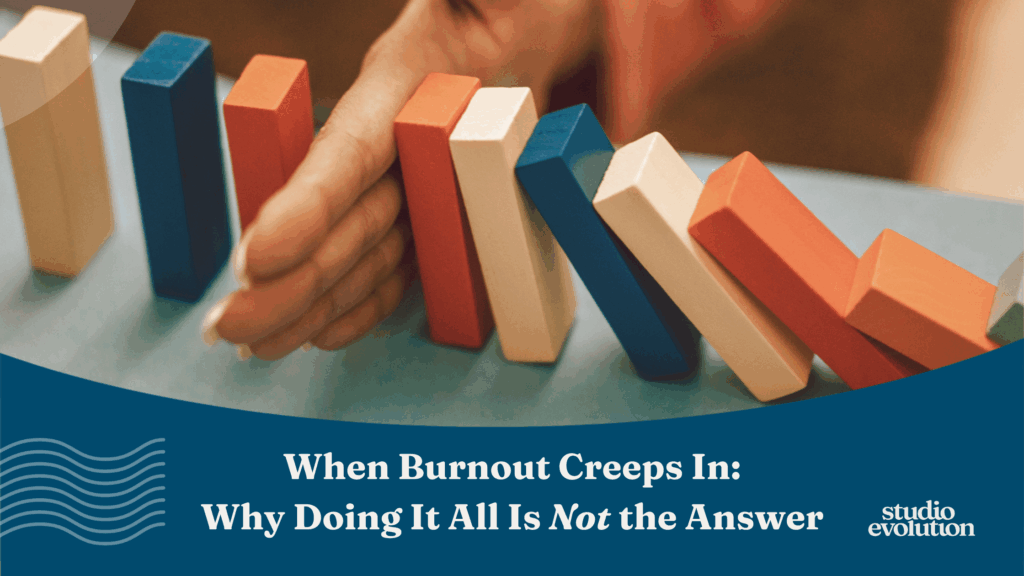Wondering if your studio setup is working for you—or maybe holding you back a bit? In this episode, Chantelle and Michelle dive into the art of simplifying: from setting just the right class capacity to creating a pricing structure that brings in clients without the guesswork. If you’re ready to bring a little more ease (and a lot more clarity) into your studio, you’re in the right place!
PLUS, get your Pricing & Packaging Masterclass HERE for just $17 (normally $247!)
Please make sure to subscribe and review if you like what you hear!
If you’ve got a studio problem you’d like us to solve, leave us a voicemail here: https://www.speakpipe.com/LeaveEvolutionAVoicemail
Be sure to follow us for more content perfect for Studio Owners!
Instagram: @thestudioevolution
YouTube: @thestudioevolution
Facebook: @TheStudioEvolution
And if you’d like some more support, find out how we could help you here:
Website: studioevolution.com/start
Chantelle Bruinsma (00:00)
Welcome to Your Studio Podcast, sharing strategies for studio owners. Chantelle Bruinsma and Michelle Hunter are co -CEOs of Studio Evolution, an online global community for studio owners who run dance, music, acting, visual arts, yoga, pilates, even woodworking businesses. Over the last decade, they have transformed the lives of thousands of studio owners, helping them to create wildly successful and profitable studios, giving studio owners the life of their dreams. So welcome home. Grab a cuppa, let’s get started.
Michelle Hunter (00:49)
It’s the Your Studio Podcast isn’t it?
Chantelle Bruinsma (00:52)
Yeah, that’s the name. We established this. We have branding.
Michelle Hunter (00:55)
We have branding, we have a photo. We’re on Spotify and on the car. Have you plugged it in and you can see the photo of us? My kids think we’re really, really
Chantelle Bruinsma (01:01)
I know, it’s wild.
We’re famous.
Michelle Hunter (01:05)
Hello friends and welcome back to the Your Studio Podcast. It is Michelle Hunter here and Chantelle Bruinsma. And it’s an exciting day. We are back. It’s a new season. It’s a new season of evolution and it’s so good to be back with you guys.
Chantelle Bruinsma (01:19)
We’re so excited to be back. It’s such a joy for this new season and we did end last season kind of sharing that Michelle was gonna be undergoing some really significant surgery and that has all happened. It’s been a bit of a journey friend and you’ve had not an easy recovery, but we’re really happy that you are back. How you doing?
Michelle Hunter (01:36)
Thank you. I’m doing good. I’ve had a lot of time to rest and relax and thank everyone for your patience and had so many beautiful community members reach out. And I have found a love for walking. Who would have thought?
Chantelle Bruinsma (01:51)
I never thought, this is shocking to me, friends, shocking.
Michelle Hunter (01:54)
You should be shocked because I used to drive my car to run places. drive it to a park and then I’d run around the park, get back in my car and come home. But I’m now walking to that park. It’s wild.
Chantelle Bruinsma (02:05)
I’m so proud of you. I’m so proud of you. Michelle and I, I love to walk I love to Bushwalk. And Michelle would like, this is the devotion of our relationship. Michelle would come with me on walks. And I knew she was really not enjoying it. I’ve got, you know, quite a stride. She’s like.
Michelle Hunter (02:20)
You are so fast. I’m practically jogging while you’re walking. I have to do little jogs in my instep to keep up with you.
Chantelle Bruinsma (02:27)
I’m so excited because next time we get together, we can actually go walking together. This is a new thing for us.
Michelle Hunter (02:31)
We can walk. It’s such a new thing. And when I was recovering and you said, come on, Michelle, when you recover, we’ll do something together. You said to me that we’re going to train for a mini triathlon together.
Chantelle Bruinsma (02:42)
Okay. So are you putting, are you actually putting this in the world? Okay. So, okay. So yes, I am, I have, I have expressed intent that has not been, I haven’t paid any money yet, but like I’ve expressed intent that I will do a mini triathlon because Michelle and I live in different States friends. So we can each train for a mini like, it’s like two kilometers of running. That’s max. I’m tapping out at that. Right. It’s like two kilometers of running. How much swimming, how much bike do you know? But like not long.
Michelle Hunter (02:57)
Mm-hmm.
Yeah, that’s fine, I’ll take it.
I think it’s like a 200 metre swim, two kilometre run and like a 10 kilometre bike But we do finish on the run. So when I did Chantelle, she was like, so we don’t get to choose the order? No, we don’t. We don’t get to choose the order.
Chantelle Bruinsma (03:21)
Because it doesn’t make sense. Why would I want to start with swimming and then have to exercise with, with water dripping down my thighs? I mean, it’s just doesn’t make sense for the chafing friends. Like who, who, no woman, no woman set the order for a triathlon. You should end with the swim. You should, you should definitely end with the swim. I’m happy to get on a bike. I can get nice and stable and then I’ll get off the bike and I’ll run and then I’ll dive in a pool and then I can get changed into nice clean clothes.
Michelle Hunter (03:36)
There’s a lot of no, I’ll set the order. Yeah, yeah.
Well, I’ll give that feedback to the triathlon organisers with the ones I’ve been looking into.
Chantelle Bruinsma (03:57)
Thank you. Thank you. If not, we’ll just create our own Evolution triathlon. We could actually put it out to all the members and say, we’re going to do
Evolution triathlon and we’re going to do it Chantelle’s order.
Michelle Hunter (04:04)
with the, my gosh, region of lobster. And it’s happened to everyone. If you’re a member of The Leap, whatever.
Chantelle Bruinsma (04:11)
You guys listen to this podcast during, in fact, you can bring your friends. can bring your friends. Non-studio owners are welcome here in our mini triathlon. should actually do this.
Michelle Hunter (04:19)
This would be like the best day of my life. Apart from my wedding, apart from my baby’s being born, apart from Contiki, I’ve got a lot of best days that I talk about. It’s up there. This is really good.
Chantelle Bruinsma (04:25)
Next. It’s up there. Okay, this is great. Just clarifying, we had not planned to talk about this on this episode, but this has now, I think, grown into a natural organic thing. All right.
Michelle Hunter (04:32)
No, we didn’t.
Yeah. Yeah. So you just got an insight into what goes on and the last nine weeks of recovery of me and Chantelle’s conversations.
Chantelle Bruinsma (04:47)
Yeah, I mean, because the whole thing was like, Michelle can’t wait to get back into your body and moving and being comfortable again, right? So this is a good goal for us to work on. It’s not going to happen like maybe this time next year, like kind of ended next year, this might happen. Watch your inboxes for a invitation friends.
Michelle Hunter (04:51)
Yeah.
Yeah, that’s right, that’s right.
Yeah, that’s right. But today we’re diving into something pretty cool, Chantelle. We’re going to be talking about class capacity in your studio.
Chantelle Bruinsma (05:11)
It’s the thing that I reckon most studio owners don’t understand to the degree that would be helpful to them and game changing for their business. This is a super underestimated element to really strategically plan for. And I’m going to, I’m ready to dive in friends. I’m ready to reveal all I know.
Michelle Hunter (05:28)
So Chantelle, when we work with studio owners or, or we speak to studio owners who haven’t worked with us before, what is their first impression when you say, how’s your class capacity going?
Chantelle Bruinsma (05:39)
It’s confronting. think is what most studio owners kind of their response is because usually it’s not great is the truth. You’ve got some programs that are doing really well more than likely sometimes during the week that have got really stable attendance and you’ve got others that are struggling and that maybe you’ve always been struggling to get the capacity high in. And that’s where it’s difficult because really what this conversation is about is about not just kind of like the marketing piece of filling classes.
Michelle Hunter (05:46)
Hmm.
Chantelle Bruinsma (06:07)
There’s actually a whole nother level and layer of conversation we’ve got to have if we’re really going to solve class capacity. And that is, it’s the broader topic of your programs and how your programs are structured. Now, when you think about it, I just want to ask you guys a few questions. Like how many programs right now do you run? Like if I went onto your class timetable on your website and like there’s these types of different classes I could enrol into.
How many do you have? And I like to think of them like every program you have is like a child. Now I am deep in parenting. I’ve got a four and a six year old, deep, deep in parenting right now. And every child needs a lot of individual attention, right? And programs are the same. Every program you have needs marketing. It needs team training. It needs dedicated teachers who are skilled in teaching that particular one.
Michelle Hunter (06:45)
Yeah. Yeah.
Hmm.
Chantelle Bruinsma (07:04)
each kind of the programs needs kind of their own attunement to like how we’re flowing through the year and retention strategies and up-skilling. So every program you have really increases the complexity of your business. And it’s no surprise, right, that complexity is difficult. So when we’re thinking about class capacity, the more variety of programs you have, the more complexity we have. And it means that people can enrol into more classes.
Now the issue with that is that the more programs that people can enrol into means that there’s a less of a likelihood you can have high capacity. So the clients we have Michelle, right? That have extraordinary high capacity have been very disciplined in their program model. And like, really consider that this is your business model. It’s kind of like, this is my business model. Like I run these programs, but where we fall into a trap is, is when people want you to offer.
extra programs, right?
Michelle Hunter (08:03)
Everything, everything. And it’s funny when you just go back to that analogy of like every program is like a baby. It’s actually like a family dynamic when you think about it. The more babies you have, the more attention, how you manage those relationships can really affect the family dynamic and in effect your whole business. And when we see some of our, or a lot of our members who are very disciplined in their program offering and in their program suite, it can transform.
Chantelle Bruinsma (08:21)
Mm. Mm.
Michelle Hunter (08:32)
a studio business and a bottom line when you have got that really well dialed in.
Chantelle Bruinsma (08:36)
Well, I’m sure right now you may be thinking of like, there may be one program that you’re running right now in your studio that you are struggling to get people into. And so what happens from a financial perspective is that you’ve got programs that are very successful, very profitable, easy to enrol into kind of really stock standard, like good to go. And they are buffering and supporting the other programs. Right. And so when that’s happening across the board, you might have one program that is like rock solid, but others are not so strong, it creates a really big impact on the business.
So the first thing to kind of start exploring this topic is to just really consider what programs do we have that are very, very successful. They’re profitable. They’ve got strong attendance. They are easy to run. You’re passionate about them. You care about them, right? Like when you start really asking questions that allow you to dive into that and evaluating on those criteria, they’re financially sustainable.
They’re strong for marketing. They’re easy to run. They’re good for retention. When we start asking like, okay, well, which ones really aren’t? And then we have to come to a point of like having some hard decisions. What if we consolidated those programs? Could we integrate that program into another? Could I bundle them? Could I create a combo kind of arrangement? Can I increase them or decrease kind of what we are offering here? This is when we get very, very strategic and very clean in what we are running. And, you know, I can give an example about this. So.
I’m, as you guys know, I love Pilates I’ve been doing it over 10 years. I’m actually like about to buy my own reformer for home, Michelle.
Michelle Hunter (10:12)
You’re so in. I love how in you are with Pilates
Chantelle Bruinsma (10:15)
So in, I can use it every day. I’m pumped. Anyway, so my Pilates teacher had some surgery and I wasn’t able to go for eight weeks. And so I went and I was researching other studios in the area so I can go to, and this is one I found that I loved. They did great things. And I went onto their website and it was so confusing. I did this for a living, right? I’m relatively qualified.
to translate studio models. I couldn’t find a kind of option that was right for me. They had like eight lines of different kind of pricing variants just for Pilates. And then they doubled that with the yoga next to it. And then there was kind of infrared and all the other things, right? There were that many different options from kind of like this many things, but this included, but that included. was like, I don’t want that. they were like, it was so convoluted that for me,
trying to decide what to do and which program to kind of step into, I actually haven’t joined. I just kind of did the class bundle. And the problem with that is that I’m a dream client for a Pilates studio. I love it. I’m consistent. I’m a lifer. I’m loyal as hell. I’m loyal as hell. And I really love it. And so if I am, if the model of like how I was going to join the studio was too complicated to the degree that
Michelle Hunter (11:20)
you’re a lifer. You’re a lifer. Yep.
Chantelle Bruinsma (11:35)
I haven’t taken action and I’ve just bought the class pack. That’s an issue, right?
Michelle Hunter (11:40)
That’s an issue. And what do you always say? And I’ve seen you, you know, go through business models with clients in person and in rooms and you say a confused mind says no. And the barrier to entry is so difficult. And when you start to ask yourself these questions that Chantelle was just talking about, like what’s the best performing? If you actually ask the right questions to yourself, you pretty much know when studio owners are like, I’m not passionate about that. I’m not passionate about this. My heart really leans towards this.
And then when you get rid of all like the offerings, when you’re trying to appease everyone, you know, we had a client at the event who said, a Mum said, I think you should start hip hop. So she said, okay. She started the class and it was, yeah, it was, it just, it was just like another service, another program in her suite that wasn’t filled and was offering.
Chantelle Bruinsma (12:13)
Mm.
Yeah.
And yeah, when you, when you’ve got prof programs that are super niche, like very, very niche, only a few people are really interested in this. only if it’s not like the bulk of the market, it’s very, very difficult to sustain from a business model perspective. And yes, there people who want it. It’s just not your responsibility necessarily to cater to it. Got to make some big decisions here. So there’s kind of two parts of this conversation friends. Number one is like listing all the programs that people could enrol into your studio, like which kind of classes.
Michelle Hunter (12:33)
Hmm.
Chantelle Bruinsma (12:58)
And the number two is like how you’re packaging it. So how we are packaging it, like I want to come X amount of times per week and have these experiences and these, that kind of equates to this cost. So we’re wanting to really work on this relationship between reducing and consolidating the number of programs you run. So what I would say is like, get a sheet of paper, write them all out and then put a star next to those that are profitable, easy to market, easy to enrol into good retention and really embody what you are passionate about. Right? So kind of, then, you know,
put an indicator of like which one’s aren’t Yeah, so there’s that kind of side of it. And the other side of this conversation is this packaging and pricing. So my test is if I called you and said, hey, I’d like to enrol in your studio, could you explain your pricing model in less than 30 seconds to me?
Michelle Hunter (13:47)
Yeah, I’ve seen this. I’ve seen this in person. And yeah, if it’s not easy, it’s not simple.
Chantelle Bruinsma (13:51)
Hmm.
Yeah, it’s not like if you’ve got multiple lines of pricing 30 minutes equals this price 45 minutes equals this why 60 minutes equals this price but then if you do this one it’s this one and then if you want to do this one it’s then this one like if you’ve got more than honestly if you’ve got more than four lines of pricing I want to kind of I call it the simple stick I want to come and poke it come on like I get my like whiteboard and like we could just get rid of that and just like drive more to less options right
Michelle Hunter (14:14)
Chantelle and her simple stick Yeah.
Chantelle Bruinsma (14:23)
We’re wanting to drive more people to less options because otherwise the complexity of management, the bookkeeping, the accounting, the kind of tracking, my God.
Michelle Hunter (14:30)
the admin.
admin, the notes, the enrolment and then even if you’re transferring, know, rolling that over to a new program, we’ve seen it with studio owners, like the notes and it’s a nightmare.
Chantelle Bruinsma (14:42)
It’s a nightmare. It’s a nightmare. And not only from it. there’s an operational cost, but it’s the marketing side. You can have the most beautiful marketing. This studio I’m talking about that I’ve been going to beautiful marketing, beautiful studio, fantastic teachers, facilities, complex business model that has made me not want to enrol such a shame, such a shame. And so like what I’m saying is like, you can have the best marketing, but unless this is really clean, the other thing I see is like,
If you, if I go to your website today, friends, and I go to your kind of like programs page or page or kind of pricing page, and it’s like all the details for all the classes on one page, there’s so much cognitive load I’ve got to do. You’re making them work through and sift through each piece of information. Do I want this, am I in this class, but that one? Like you’re making them think so much. Take that all out, friends. What I really recommend is like navigate them through the website based on what program they’re appropriate for.
So I’m looking for this age group. I’m looking for reformer Pilates I’m looking for this type of guitar lessons, right? Take them there, educate them on that experience and then say, hey, you can come in on Tuesdays, Thursdays or Saturdays. It’s X amount per month, click here to enrol. Don’t make them sift through all the information of your entire studio. Just give them the information that’s relevant to them. Michelle, we might do a whole episode on website strategy, cause I’ve got a lot to say.
Michelle Hunter (16:03)
100%. And this, and I was just saying, this is going into a whole nother realm of making that and optimizing that enrolment page to really perform for you and do the sole purpose that it is designed to do. And that is for when people land on it, that they enrol.
Chantelle Bruinsma (16:18)
That’s right. But the secret to this is discipline. Something that Michelle, your middle name is discipline. Michelle Discipline Hunter is your actual name. Because people, we start to expand our business models. We start to add more programs. We start to kind add more variants of kind of class packs here and kind of introductory bundles here and kind of like these tiers of membership here. We try and make people happy.
and all it does is it adds complexity. We think that kind of adding this is gonna attract more, but it actually detracts from the capacity you have in your classes and increases the complexity you in your business.
Michelle Hunter (16:56)
So let’s talk to like when we’re looking to see which, which programs we can, you know, kind of consolidate or remove to continue that discipline, right? Can we just speak to the fear factor? Because I know that this, comes into it. Like I see a lot of fear when they’re going to do it. And for me, a lot of fear gets taken out when I forecast it’s like, you’re fearful. Let me show you what your studio will look like if you continue this way and continue to pay all these teachers and admin operational load. But can we really speak to that fear piece? Cause it’s something that we do see.
Chantelle Bruinsma (17:02)
Mm.
yeah.
Hahaha
Michelle Hunter (17:26)
a lot and it’s real and you know, and just really honouring the studio owners in that moment when they have to make that decision because it’s huge.
Chantelle Bruinsma (17:34)
Well, and as you said, it’s when you kind of see the numbers on the page. So Michelle, do you want to kind of even speak to like that wonderful formula you like to do of kind of what it costs to run a program? You know, like actually, like when you see the numbers of, you know, what you’re having to spend and then how many students you have and how much a program makes, you can do that by program. And it is a sobering number. It’s a sobering number sometimes.
Michelle Hunter (17:55)
It is a sobering moment. that’s something that we do with studio owners and that we do ourselves in our business here at Studio Evolution. And it’s pretty much going through a fine tooth comb and it, I love doing it. It’s just recording all the operational expenses, marketing expenses, time allocations, and even all like physical resources that go into the delivery planning, and in studios, it’s not just paying the teachers. It’s not just paying the rent. It’s also your time investment.
costuming, recitals, packaging, all that together and knowing what it is viable to all the costs for one student per program a month. And that’s really important because that’s going to give bring you to the number where you know that you need to meet to sustain that program. And that’s really, really important.
Chantelle Bruinsma (18:47)
And so that takes away the fear a bit. It’s kind of like it’s the brutal truth, right? Of being able to go like, this program here is losing money.
Michelle Hunter (18:55)
Yeah, it is. And we work through a project in Studio Evolution with our members when you see them have a lot of fear and then we actually take them through this actual process. And when they go, my gosh, I need at least, well, you’re just going to grab it now. Yeah. I need 20 students to sustain this class. And I currently got three.
Chantelle Bruinsma (19:04)
yeah, let get it.
Michelle Hunter (19:14)
Here we go. So Chantelle’s just picked up the Elegant Ease binder, which is the Pillar that we’re actually currently in at Chantelle.
Chantelle Bruinsma (19:21)
Yeah.
This one, this one here, this project is called Business Model. And in this project, it is all about absolutely walking through what it is we’re bringing into the world. Because we can have the nicest marketing, but if we’re taking them to a place that is kind of not supporting your capacity and not supporting your profitability and not creating ease in your life, we’re no better off, right? And that’s why this whole purple Pillar is called Elegant Ease. And this project here,
Michelle Hunter (19:22)
There you go.
Mm-hmm.
Chantelle Bruinsma (19:52)
is all about understanding how to simplify your pricing. So for example, this here is a normal example of a lot of studios pricing and it’s pricing based on increments of 15 minutes. But that’s not the most simplistic way to go about it because also what I’ve seen in a lot of clients is that for every 15 minutes there’s a kind of discount applied, right? So you’re kind they’re doing more time with you but they’re actually paying less. And so it’s about finding the sweet spot of how can I bundle and drive people to a particular
amount of time per week that’s going to be convenient and get the educational outcomes we want, but also be really profitable for the business. Cause I’m sure there’s a of people listening to this conversation. Like the kids who come the most, the students who come the most per week, I make the least off. Right. And then you’ve got the kind of the kids who come like 45 minutes a week and they’re the profitable programs that are supplementing the other ones. These are the real core issues of studio business models that I’m here to resolve.
that what we do here in Studio Evolution is resolve these issues once and for all. And that’s what gets you the growth because we’re not trying to have the energy being siphoned into these small little programs. We’re like this one, these two or three or four programs are the sweet spot and we’re drive everything there, cleans it all up
Michelle Hunter (21:07)
It does clean it all up. And look, there can be a little crunchy transition period bit when we do go to consolidate, but it’s funny. Like when our members have all this preconditioning and they come over like, I got two emails in the transition out of 200 students. So sometimes our perception and the story we tell ourselves to what actually does happen is the truth can be very different.
Chantelle Bruinsma (21:20)
Yeah.
Honestly, this is the project that creates the most transformation. One of the projects that creates the most transformation in our clients, because we start to see rapid growth once you have kind of really tightened up what you’re offering and made it easier for people to enrol. If there’s resistance, it’s trickier. So once we get you the place of like understanding, okay, this is why you probably haven’t had growth in your business. The reason marketing has been hard because you’ve had a very complex pricing model and there’s been, you know, we haven’t been driving them to a profitable offering.
So once we get that actually resolved, what then happens is that we, you can do the same amount of marketing, but we’re getting better. We’re driving them to a better outcome. So the business starts performing better. And so then you start to see like, it’s not that you’re not doing enough marketing, right? It’s not that your programs aren’t doing well. It’s just that we were kind of had the wrong model that wasn’t serving you. And you can still continue to deliver these beautiful classes. You can still share the word of marketing really beautifully.
We just needed to fix up your pricing model. We just needed to take out a few lines and simplify it. We just needed to kind of work on your timetabling to get the most optimal arrangement, right? And when you get those, it’s like, the model works. Like the magic is in the model. The magic is in the model.
Michelle Hunter (22:42)
So is, it’s so is and it affects so many aspects. So the beginning when you say what’s capacity, you just think of the amount of people in the class, but it affects everything. As you said, just your pricing, your marketing, how you advertise, your online performance. It’s so multifaceted.
Chantelle Bruinsma (23:00)
what team you need to hire, like specialist teachers versus kind of like broader skill teachers, like the operational efficiencies, the admin load, like there is so much to gain from working on this. And look, I’m not going to sugar coat it. These are some of the hardest conversations we’ve got to have with our clients. These are some of the hardest ones, but for me, they’re the most joyful because it’s like your world is about to change. Your life is going to get so much fucking easier and you’re going to see so much growth because we’ve actually got a model that works for you.
Michelle Hunter (23:16)
show.
Chantelle Bruinsma (23:30)
and it feels good.
Michelle Hunter (23:32)
And how, what like, and what’s on the other side? So the studio owners who, you know, coming to the second rotation of doing Elegant Ease and they’re now Grads and they’ve gone through the process. And it’s just amazing. As you said, the growth just keeps on going because it starts with the model. Like it’s all locked in.
Chantelle Bruinsma (23:46)
We had, I remember one client, Julie Woo one of our Grads, love her to bits. She did this project in her first four months in Studio Evolution. First four months, this was the first thing she came in and did. Within four months, she doubled her revenue. She was at capacity in her studio within months after that because we got this right. We got this right. And now she’s about to open her second location. Da da da da da. It’s all happening. You get the model right, everything flows, friends.
Michelle Hunter (23:53)
She did too. She did too.
It’s all happening.
Chantelle Bruinsma (24:15)
And I think that these are the difficult things to grapple with by yourself. And that’s why Studio Evolution is such a powerful program because you actually have the support of experts to guide you through. here’s another way you could set up your pricing model. Here’s another variation of how you could do it, right? You don’t have to do it on your own. Sometimes we need this expert support to help us get really clear on finding the business model that is going to be the most impactful for your market, for your vision and for your business. It’s pretty cool.
Michelle Hunter (24:40)
Yeah, and working in a group of like-minded studio owners or, you know, and just bouncing that is invaluable.
Chantelle Bruinsma (24:46)
Yeah, because you get to see like, we can do hard things. We can do tricky things and we can make these beautiful enhancements in our business and, see it all pay off. And it becomes less scary because we’re all doing it together. But Michelle, we’ve got something, a little special treat for you all today. So I’ve recorded a really in-depth training. it was a bonus for The Leap, but we’ve actually kind of got a really very, very special promotion on right now. And it’s this pricing and packaging masterclass. It’s an in-depth training where I walk you through.
how to kind of take your business model from being quite complex and with many layers of pricing and a lot of complexity in the packaging and simplify it. And that’s normally retails for $247. And we’re actually offering it now for a very, very special little winner for 17 bucks. Like what a deal, what a steal, because we know that this is the stuff that’s gonna move the needle in your business. This is the stuff that’s gonna really help your life be easier and change what’s happening in your life. So.
We’re really excited.
Michelle Hunter (25:43)
you can just head to studio evolution.com forward slash start. And right there, you have the prompt to click into the pricing and packaging training and like $17. You pay more for a cup of coffee and a toasted sandwich these days. And we’ve had people in The Leap who have just done that training alone and, you know, posting in our Leap Facebook group of how much changes and ease have come just from watching that training. So again, go to studio evolution.com forward slash start and dive in.
Chantelle Bruinsma (25:57)
I know I do.
The magic is in the model, get the model right. Everything becomes easier. Marketing, profitability, you name it. Go and have fun my friends, go watch this training. And we’re going to see you for so much more joy and wonder and good conversation here in season two of Your Studio Podcast Michelle and I are just so grateful to be back here and we’ll see you next time. Bye.
Michelle Hunter (26:30)
See you soon friends, bye.
Chantelle Bruinsma (26:33)
And it seems like we’re going to be doing a company-wide triathlon. So…
Chantelle Bruinsma (26:40)
Love what you hear? Make sure to hit subscribe so you don’t miss an episode and leave us a review. Interested in working with us and want to find out more about how we can help you? Head to studioevolution .com forward slash start.
